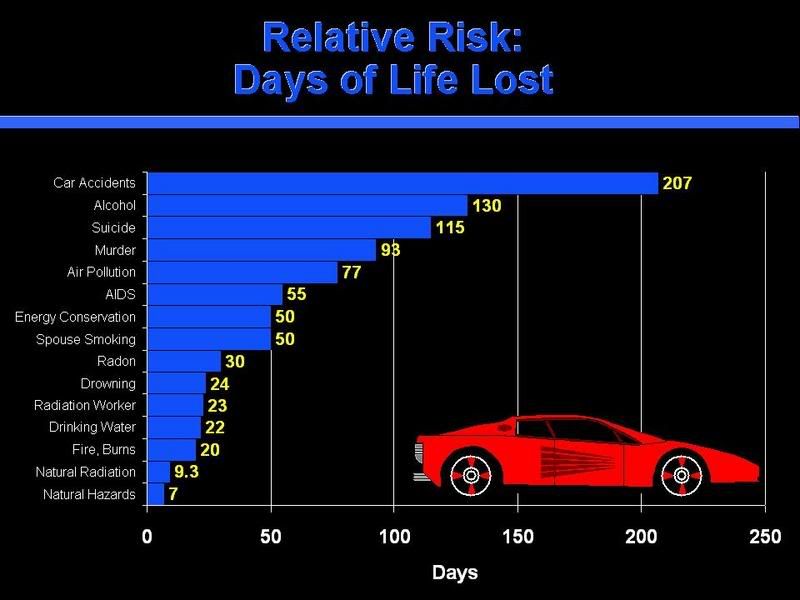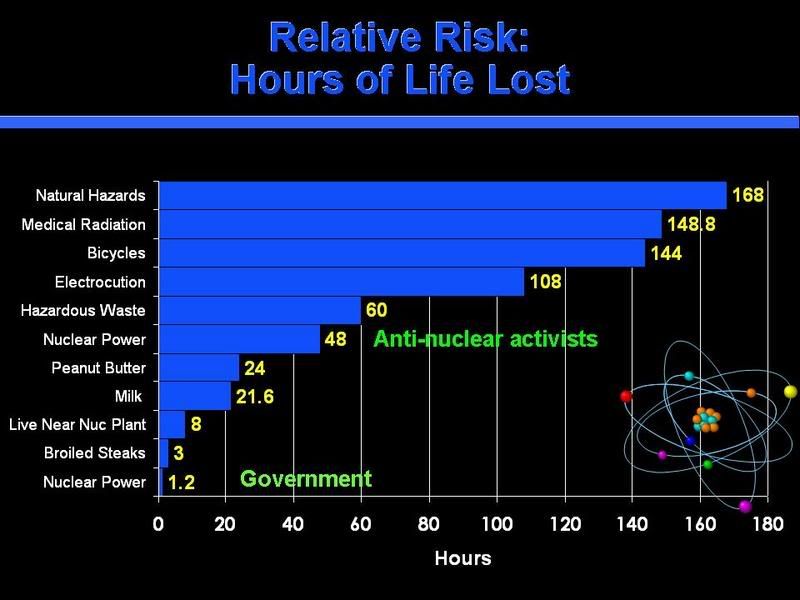Don't invite cancer
Moderator: Available
Yes, dividing cells are more susceptible to radiation. It's how you can manage to kill cancer cells and only some of the regular cells with therapeutic radiation.
But the amount of radiation we're talking about ought not to kill cells. It's at a level where it might induce a few mistakes that cause trouble down the road. I don't see it reliably, to any degree, cleansing us of cancer / precancer cells for the exact same reason it doesn't cleanse us of spermatozoa and the lining of our stomachs or the rapidly dividing blood cells.
Cancer cells go haywire and in the process of growth, make many many individual errors in each cell that don't reliably add up to death--why should the rare radiation induced error be worse?
As for radiation and evolution, sure, it may have nutured us from tadpole to chicken to ape to taekwondoist to uechi-ka. However, I would be quite surprised if 1) we had sufficient influence over radiation to change the course of evolution or 2) any influence of radiation weren't vastly outweighed by all the weird factors going into human reproduction right now.
But the amount of radiation we're talking about ought not to kill cells. It's at a level where it might induce a few mistakes that cause trouble down the road. I don't see it reliably, to any degree, cleansing us of cancer / precancer cells for the exact same reason it doesn't cleanse us of spermatozoa and the lining of our stomachs or the rapidly dividing blood cells.
Cancer cells go haywire and in the process of growth, make many many individual errors in each cell that don't reliably add up to death--why should the rare radiation induced error be worse?
As for radiation and evolution, sure, it may have nutured us from tadpole to chicken to ape to taekwondoist to uechi-ka. However, I would be quite surprised if 1) we had sufficient influence over radiation to change the course of evolution or 2) any influence of radiation weren't vastly outweighed by all the weird factors going into human reproduction right now.
--Ian
- Bill Glasheen
- Posts: 17299
- Joined: Thu Mar 11, 1999 6:01 am
- Location: Richmond, VA --- Louisville, KY
I totally can't figure out where you are coming from, Ian. This has nothing to do with anything in this thread.IJ wrote:
I would be quite surprised if 1) we had sufficient influence over radiation to change the course of evolution
This is a theoretical discussion. Control is background radiation. What happens if you make background radiation go away? There are competing theories - all listed.
The hormesis theory didn't come out of a vacuum, Ian. A number of researchers actually found that less-than-background radiation levels resulted in shorter animal model lifespans. The explanation followed the data.
The effects are small, and not worth worrying about. But the explanations make sense to me.
- Bill
"There are other things to consider. Evolution as we know it requires a mutation now and then. Is this a totally random event, or is it triggered by some stray gammar radiation particle? While the vast majority of mutations are bad, some changes are good. Would life be evolved as much as it has in the absence of any radiation at all? It's difficult to say."
That's where I'm coming from. Your bringing this up suggested you thought we shouldn't attempt to alter background radiation if and when we could.
I still don't see how minimal radiation which doesn't kill rapidly dividing nonprecancerous cells will clean out the very rare precancerous cell, and yeah, I acknowledged the data that lead to the hormesis theory way back, but ok.
That's where I'm coming from. Your bringing this up suggested you thought we shouldn't attempt to alter background radiation if and when we could.
I still don't see how minimal radiation which doesn't kill rapidly dividing nonprecancerous cells will clean out the very rare precancerous cell, and yeah, I acknowledged the data that lead to the hormesis theory way back, but ok.
--Ian
- Bill Glasheen
- Posts: 17299
- Joined: Thu Mar 11, 1999 6:01 am
- Location: Richmond, VA --- Louisville, KY
That's a fair assumption.Ian wrote:
Your bringing this up suggested you thought we shouldn't attempt to alter background radiation if and when we could.
It's always best to understand what makes us as individuals thrive as we do before mucking with things. For example... Sickle cell exists because carriers of the gene don't die of malaria. OK... Now we know why it is prevalent in certain areas of the world. Red-heads get better Vitamin D production in northern climates than folks with darker complexions. OK... Now we know why red-heads are prevalent in certain parts of the world.
So... Now that we understand it, we can feel safe eradicating the sickle cell gene in a civilized society, and telling red-heads who live in Florida to use sun screen. We aren't however likely to tell a person with a dark complexion to go populate a world where there's little light and little food.
The whole hormesis thing came up because we must work with radiation. I worked for 4 years with radiolabled microspheres. My research probably saved lives. But I did put myself at risk to the ravages of ionizing radiation in the process. The operating acronym for me was ALARA. But...
When folks watched over me and looked at my exposure badges, they had to understand how much was too much. Sooo.... The research that informed their processes and actions looked at the relationship between low-level ionizing radiation and health risk. Could they come up with a "threshold" below which you were safe? Does some exposure always increase your risk? These were questions that needed to be answered before setting risk bechmarks.
And when doing the research at low levels of radiation, they found some interesting stufff. They're still trying to figure it out.
At the very low levels, the risks are really low. So it's difficult to get enough data to estimate the odds ratios with any degree of precision.
- Bill
That's where life gets easier, though, at that minute risk point, right? You can fuss all day about whether super low level radiation might cause unmeasurably low risk, no increased risk, or possible benefit, but I'm not sure its worth the effort when people are going to be driving home on the interstate. I don't expect radiation perfection, once measurable risk is eliminated.
It's a little bit like the IRB fussing about the exact way we measure some aspect of hospital practice (because it entails protected health information and might entail the release of some collated data about medication receipt or catheter days) when measuring practice is vital to protecting those same people from serious risks in the hospital -- and more to the point, much more sensitive PHI is available up on the wards to anyone who wanted to snop around.
Everyone ought to have a Pareto chart before writing their aim statements...
It's a little bit like the IRB fussing about the exact way we measure some aspect of hospital practice (because it entails protected health information and might entail the release of some collated data about medication receipt or catheter days) when measuring practice is vital to protecting those same people from serious risks in the hospital -- and more to the point, much more sensitive PHI is available up on the wards to anyone who wanted to snop around.
Everyone ought to have a Pareto chart before writing their aim statements...
--Ian
- RACastanet
- Posts: 3744
- Joined: Thu Mar 11, 1999 6:01 am
- Location: Richmond, VA
Ian stated:
To that point, here is the chart:

Yep, background radiation is a non-event.
Rich
That's where life gets easier, though, at that minute risk point, right? You can fuss all day about whether super low level radiation might cause unmeasurably low risk, no increased risk, or possible benefit, but I'm not sure its worth the effort when people are going to be driving home on the interstate. I don't expect radiation perfection, once measurable risk is eliminated.
To that point, here is the chart:

Yep, background radiation is a non-event.
Rich
Member of the world's premier gun club, the USMC!
- RACastanet
- Posts: 3744
- Joined: Thu Mar 11, 1999 6:01 am
- Location: Richmond, VA
I do not have water but do have peanut butter and milk, among other things...

I believe thi info is international. Here are the refernces:
1. Casarett, A.P., Radiation Biology, Prentice Hall, Inc., Englewood Cliffs, NJ, 1968.
2. Cember, Herman, Introduction to Health Physics, 3rd. Ed., McGraw-Hill, New York, NY, 1996.
3. Gollnick, Daniel A., Basic Radiation Protection Technology, 3rd Ed., Pacific Radiation Corporation, Altadena, CA, 1994.
4. International Commission on Radiological Protection (ICRP), 1990 Recommendations of the ICRP, Report #60, Pergamon Press, Elmsford, NY, 1991.
5. International Commission on Radiological Protection (ICRP), Risks Associated with Ionizing Radiations; Annals of the ICRP, Volume 22, No. 1, Pergamon Press, Elmsford, NY, 1991.
6. Moe, H. J., Operational Health Physics Training, ANL-88-26 Corrected, United States Department of Energy, 1992.
7. National Academy of Sciences/National Research Council (NAS/NRC), Health effects of exposure to low levels of ionizing radiation: BEIR V; Washington, D.C., National Academy Press, 1990.
8. National Council on Radiation Protection and Measurements, NCRP Report No. 93, Radiation Exposure of the Population of the United States, Washington, D.C., 1987.

I believe thi info is international. Here are the refernces:
1. Casarett, A.P., Radiation Biology, Prentice Hall, Inc., Englewood Cliffs, NJ, 1968.
2. Cember, Herman, Introduction to Health Physics, 3rd. Ed., McGraw-Hill, New York, NY, 1996.
3. Gollnick, Daniel A., Basic Radiation Protection Technology, 3rd Ed., Pacific Radiation Corporation, Altadena, CA, 1994.
4. International Commission on Radiological Protection (ICRP), 1990 Recommendations of the ICRP, Report #60, Pergamon Press, Elmsford, NY, 1991.
5. International Commission on Radiological Protection (ICRP), Risks Associated with Ionizing Radiations; Annals of the ICRP, Volume 22, No. 1, Pergamon Press, Elmsford, NY, 1991.
6. Moe, H. J., Operational Health Physics Training, ANL-88-26 Corrected, United States Department of Energy, 1992.
7. National Academy of Sciences/National Research Council (NAS/NRC), Health effects of exposure to low levels of ionizing radiation: BEIR V; Washington, D.C., National Academy Press, 1990.
8. National Council on Radiation Protection and Measurements, NCRP Report No. 93, Radiation Exposure of the Population of the United States, Washington, D.C., 1987.
Member of the world's premier gun club, the USMC!
- Bill Glasheen
- Posts: 17299
- Joined: Thu Mar 11, 1999 6:01 am
- Location: Richmond, VA --- Louisville, KY
